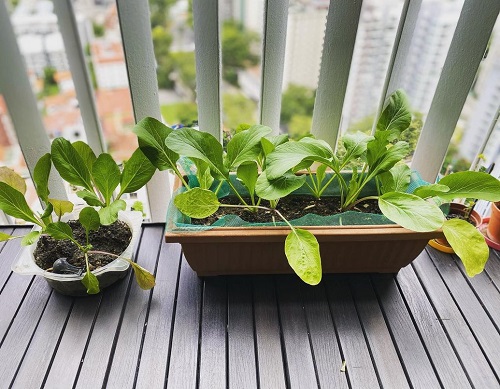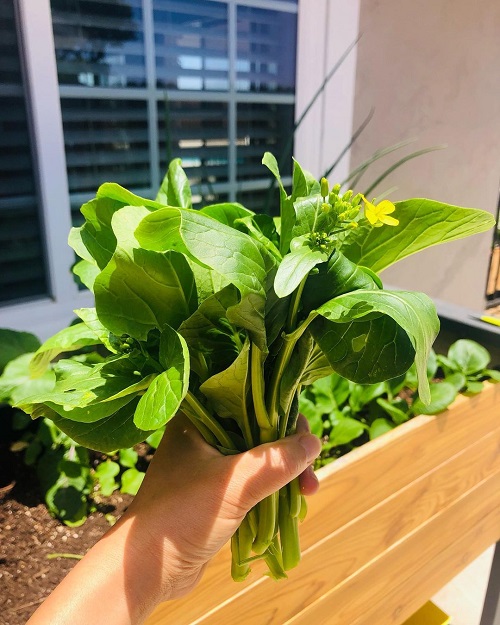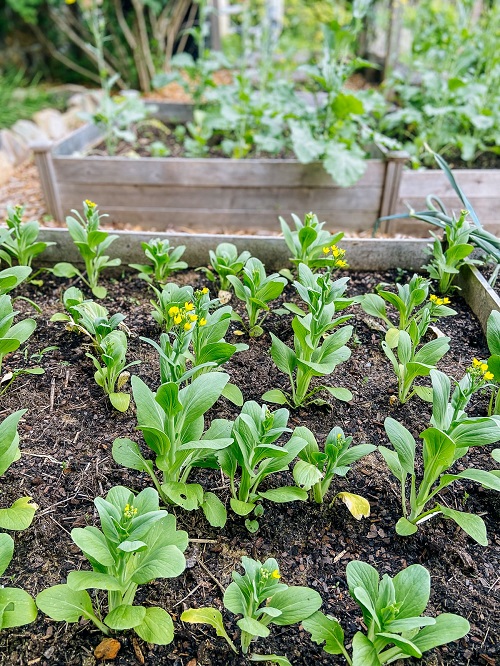Choy Sum (Yu Choy) is a delicious green that you must try growing in pots. Here’s a detailed guide to help you out!
Choy Sum delivers an initial taste that is pleasantly sweet. Unlike some other greens that might lean towards bitterness, this green lures you in with its subtle sweetness that is sure to be a hit among both adults and children. This article offers easy steps for the successful planting, nurturing, and harvesting of Choy Sum (Yu Choy) – a nutritious and tasty Asian vegetable!
Learn Growing Bok Choy in Water here
Choy Sum (Yu Choy) Information
Choy Sum, also known as Yu Choy, belongs to the Brassicaceae family, sharing a relationship with mustard, broccoli, and cauliflower. Originating from China, it is often referred to as the ‘heart of the vegetable’ in English. Its botanical name is Brassica rapa var. Parachinensis.
Choy Sum exhibits a moderate growth rate, making it neither too fast nor too slow to develop. It typically attains a height of 6 to 8 inches (15 to 20 cm). In terms of its spread, it maintains a similar range of 6 to 8 inches.
All parts of the plant are edible. Its leaves and stalks present a distinctive flavor characterized by a mild green bitterness, along with a peppery and mustard-like undertone. Notably, its flavor profile is slightly sweeter compared to other leafy vegetables.
Learn Everything About Growing Pak Choi In Containers here
Propagating Choy Sum

Propagation Methods for Choy Sum:
- Seed Propagation
- Transplanting
Easiest Method – Seed Propagation:
Seed propagation is one of the simplest methods to grow Choy Sum. Here’s a detailed explanation of the process:
- Obtain the seeds from a reliable source, such as a gardening store or seed supplier. Make sure the seeds are of good quality and not expired.
- Fill a seed tray or small pots with a well-draining seed-starting mix. Moisten the mix slightly to create a suitable environment for seed germination.
- Gently sprinkle the seeds over the surface of the soil in the seed tray or pots. Press them lightly into the soil, ensuring good seed-to-soil contact.
- Sprinkle a thin layer of the seed-starting mix over the seeds to cover them. This layer should be relatively thin, as its seeds are small. Mist the soil with water to settle it in place.
- Cover the seed tray or pots with a clear plastic lid or plastic wrap to create a mini greenhouse effect. This helps retain moisture and creates a suitable environment for germination.
- Place the seed tray or pots in a warm and bright location, but avoid direct sunlight at this stage. A window sill with indirect light works well.
- Choy Sum seeds usually germinate within 7 to 10 days. Keep an eye on the soil moisture and ensure it remains damp but not waterlogged.
- Once the seedlings have developed their first set of true leaves, you’ll need to thin them out. This means removing weaker seedlings to give the remaining ones more space to grow.
- When the seedlings are about 4 to 6 inches tall and have a few sets of leaves, they are ready to be transplanted into their final growing location.
Check Vegetables You Can Plant in August and Harvest in September here
Best Pot Size for Growing Choy Sum
For optimal growth of Choy Sum, an ideal pot size is around 10-12 inches in diameter, would be a great start. If you want a harvest for a family of 4, then up the pot size to 16-18 inches wide with 6-8 inches of depth and grow 2-3 plants in it.
Check Best Cruciferous Vegetables You Can Grow here
Requirements for Growing Choy Sum
Location
Choy Sum thrives in full sun, requiring at least 5-6 hours of direct sunlight daily. Plant it in a location where it’s protected from strong winds. Do not keep it in a shaded spot as it will result in smaller and less flavorful leaves.
Soil
The plant thrives in well-draining soil with a pH of 6.0 to 7.5. Use this mix for the best harvest:
- Garden Soil: 40%
- Compost: 30%
- Perlite or Vermiculite: 15%
- Coconut Coir or Peat Moss: 10%
- Organic Fertilizer: 5%
Water
Watering is a crucial part to prevent the leaves from developing a bitter taste and also help the plant from bolting. To do this, water it only when the topsoil feels a little dry to the touch.
Do not water it on daily basis and also make sure that the growing medium is never going dry completely.
Temperature
Choy Sum thrives in cooler temperatures. The ideal temperature range for its growth is around 50°F to 85°F (10°C to 30°C). This cooler climate supports healthy leafy growth and prevents premature flowering (bolting).
Check Vegetables You Can Grow in Water here
Choy Sum Care
Fertilizer
It is best to go for organic options like compost, fish emulsion, warm castings and bone meal. Use them once in 6-8 weeks – this would be just fine.
Alternatively, you can also go for a 10-10-10 or 14-14-14 feed. Fertilize every 4-6 weeks, after diluting the feed to 1/2 of its strength. This will ensure that you can feed Choy Sum more often, resulting in bigger leaves.
Pests:
Aphids: These small insects feed on plant sap and can distort growth. They often congregate on new growth and the undersides of leaves.
Cabbage Worms: These are the larvae of butterflies and moths. They feed on leaves, leaving behind holes and damage.
Flea Beetles: These tiny beetles chew small holes in the leaves, giving them a “shot-hole” appearance.
Slugs and Snails: These mollusks can munch on leaves, particularly in damp conditions.
Cabbage Loopers: Similar to cabbage worms, these caterpillars can cause damage by chewing on leaves.
Diseases:
- Downy Mildew: This fungal disease causes yellow spots on leaves, often accompanied by a white, powdery growth on the undersides.
- Clubroot: A soil-borne pathogen that leads to swollen roots and stunted growth. It affects the entire Brassica family.
- Black Rot: A bacterial disease that causes yellow V-shaped lesions on leaves, often leading to wilting and plant death.
- White Rust: Another fungal disease, it causes white pustules on the undersides of leaves and can distort the growth of affected parts.
- Alternaria Leaf Spot: This fungal infection creates brown to black spots on leaves, which can eventually cause leaf drop.
Protect Choy Sum by practicing proper spacing, crop rotation, and ventilation. Remove infected plant material, maintain garden cleanliness, and promote natural predators like ladybugs. Use organic remedies like neem oil for pests.
Harvesting Choy Sum

Choy Sum usually becomes ready for harvest 45 to 60 days after planting, depending on the growing conditions and specific variety. There are some signs that indicate Choy Sum is ready for harvest:
- Leaf Size: The leaves should be fully opened and vibrant in color.
- Stem Thickness: Stems should be around the thickness of a pencil.
- Flower Buds: Harvest before the yellow flower buds have fully opened to ensure the plant is tender.
Steps:
- Cut Above the Base: Use the scissors or shears to cut the stalks at least 2 inches above the base of the plant. This encourages the plant to continue growing for future harvests.
- Select Stems Wisely: Cut the outer leaves first, allowing the inner leaves to continue to grow.
- Handle with Care: Hold the cut stems gently to avoid bruising or damaging the plant tissue.
- Immediate Use or Storage: Choy Sum is best when used immediately after harvesting, but it can also be stored in the refrigerator for up to one week.
Check the Best Vegetables that are Ready to Harvest in Less than 2 Months here
How to Cook with Choy Sum
Stir-Frying
- Heat Oil: In a wok or large skillet, heat a small amount of oil over medium-high heat.
- Add Aromatics: Optional ingredients like garlic, ginger, or shallots can be added first.
- Stir-Fry Choy Sum: Add the stems first, followed by the leaves, stirring constantly.
- Season: Toss with soy sauce, oyster sauce, or sesame oil for flavor.
Boiling
- Boil Water: Bring a large pot of water to a rolling boil.
- Blanch Choy Sum: Add Choy Sum and cook for 1-2 minutes until tender but still vibrant.
- Drain: Remove and drain well, optionally rinsing with cold water to stop cooking.
Steaming
- Prepare Steamer: Fill a pot with water and bring it to a simmer; place a steamer on top.
- Steam Choy Sum: Place leaves in the steamer and cover.
- Cook Time: Steam for 3-5 minutes until the leaves are wilted but still green.
Grilling
- Preheat Grill: Heat the grill to a medium-high setting.
- Prep Choy Sum: Toss the stems and leaves lightly in oil and seasonings.
- Grill: Place the leaves on the grill and cook for 2-3 minutes per side.
Check Best Shade Loving Vegetables here
Yu Choy vs Bok Choy
Origin and Family
- Yu Choy: Belongs to the mustard family
- Bok Choy: Part of the cabbage family
Appearance
- Yu Choy: Features slender, green stems and smaller leaves; yellow flowers are common.
- Bok Choy: Has broader, white stems and dark green leaves; rarely flowers when harvested young.
Taste
- Yu Choy: Offers a sweet initial taste with mild mustard undertones.
- Bok Choy: Exhibits a more neutral, cabbage-like flavor and is less sweet.
Texture
- Yu Choy: Crisp stems and tender leaves.
- Bok Choy: Crunchy stems and leaves, with the leaves being somewhat softer.
Yu Choy vs Gai Lan
Origin and Family
- Yu Choy: Part of the mustard family
- Gai Lan: Also known as Chinese Broccoli, belongs to the cabbage family
Appearance
- Yu Choy: Features slender green stems, smaller leaves, and often has yellow flowers.
- Gai Lan: Displays thicker stems, larger leaves, and occasionally, small white flowers.
Taste
- Yu Choy: Characterized by a sweet flavor profile with a mild mustard undertone.
- Gai Lan: Offers a more robust, earthy taste with a hint of bitterness.
Texture
- Yu Choy: Has crisp stems and tender leaves.
- Gai Lan: Offers a chewier texture in both the leaves and stems.
FAQs- Growing Choy Sum (Yu Choy) in Pots and Gardens
1. Can I grow Choy Sum in pots?
Yes, Choy Sum can be successfully grown in pots as long as the pot is large enough to accommodate its growth. Choose a container with good drainage and use quality potting mix.
2. Can I companion plant Choy Sum with other vegetables?
Yes, Choy Sum can be companion-planted with other cool-season vegetables like radishes, lettuce, and carrots.
3. Can I use its flowers in cooking?
Yes, Choy Sum flowers are edible and can be used in cooking. They have a mild flavor and can add a touch of color to dishes.





